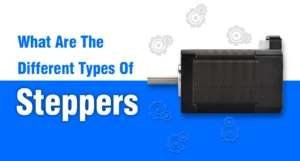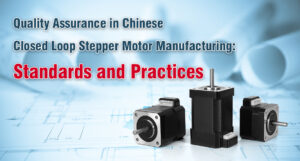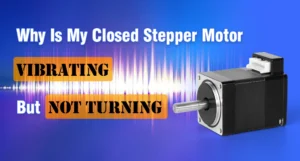Stepper motors play a crucial role in various industries, powering precision machinery and automation systems. These motors are known for their ability to divide a full rotation into a series of steps, providing precise control over movement. In this blog, we will delve into the world of stepper motors, exploring the different types and their applications.
Different Types of Stepper Motors
There are three basic stepper motor types.
- Permanent Magnet Stepper Motors
- Variable Reluctance Stepper Motors
- Hybrid Stepper Motors
- Open loop Stepper Motors
- Closed loop Stepper Motors
Permanent Magnet Stepper Motors(PM)
One of the most common types, permanent magnet stepper motors has a rotor with permanent magnets. These magnets interact with the electromagnetic fields produced by the stator, causing the rotor to move in discrete steps.
This type of stepper motor has a distinctive magnetic field structure, resulting in smoother operation. They are preferred in applications demanding high performance and low noise.
Pros:
Simple construction
Cost-effective
High torque at low speeds
Cons:
Lower torque density
Lower efficiency compared to other types
Applications:
Printers
Plotters
Medical devices
Variable Reluctance Stepper Motors (VR)
Variable reluctance stepper motors operate based on the principle of magnetic reluctance. The rotor is attracted to the stator teeth when they are energized, causing movement. These motors are valued for their simplicity, low cost, and suitability for applications with low torque requirements.
Pros:
High torque density
Better efficiency than permanent magnet steppers
Cons:
More complex design than permanent magnet steppers
Higher cost
Applications:
Robotics
Industrial automation
Packaging machinery
Hybrid Stepper Motors(HB)
Combining the best features of both permanent magnet and variable reluctance types, hybrid stepper motors offer high torque and precision.
They feature a rotor with permanent magnets and teeth, providing enhanced performance in terms of accuracy and efficiency. Hybrid steppers find applications in CNC machines, robotics, and other high-precision systems.
Pros:
Higher torque density than permanent magnet steppers
Better efficiency than variable reluctance steppers
Precise control
Cons:
Moderately complex design
Higher cost compared to permanent magnet steppers
Applications:
CNC machines
3D printers
Laboratory automation
Open loop Stepper Motors
Open-loop stepper motors operate without feedback. They rely on an open-loop control system, making them simpler and cost-effective. However, they may experience a loss of steps, leading to position inaccuracies.
Pros:
Simple control system
Cost-effective
Cons:
Prone to loss of steps
Limited accuracy
Applications:
Low-precision applications
Cost-sensitive applications
Closed Loop Stepper Motors
Closed loop stepper motors use feedback systems to correct errors and ensure accurate positioning. Encoders or sensors provide information to the control system, enhancing performance and reliability.
Pros:
Improved accuracy
Reduced risk of step loss
Better overall performance
Cons:
Higher cost compared to open-loop systems
Applications:
CNC machining
Semiconductor manufacturing
High-precision positioning systems

Customized Stepper Motors
With advancements in manufacturing and technology, it’s common to find stepper motors customized to meet specific application requirements. These customizations may include modifications to torque, step resolution, size, and other parameters to ensure optimal performance in specialized environments.
Customized stepper motors play a crucial role in niche industries where off-the-shelf options may not suffice.
Pros:
Tailored to specific application needs
Optimized performance
Cons:
Higher development cost
Longer lead times
Applications:
Specialized industrial equipment
Unique automation systems
How to select the steppers?
Selecting the right stepper motor for a specific application involves considering several crucial factors to ensure optimal performance and efficiency.
Here’s a guide on how to select steppers and the main considerations to take into account:
- Load Requirements:
Determine the load requirements of your application, including the required torque and speed. Different types of stepper motors provide varying levels of performance, so choosing one that suits your load is crucial.
- Precision Requirements:
For applications demanding high-precision positioning, opt for a stepper motor with higher resolution and better control capabilities.
- Environmental Conditions:
Take into account the environmental conditions of your application, such as temperature and humidity. Choosing a stepper motor that can withstand the specified conditions enhances the overall system reliability.
- Cost and Power Requirements:
Balance your budget and power requirements when selecting a stepper motor. Some applications may demand high power, while others may benefit from a more economical choice.
- Control Method:
Decide between open-loop and closed-loop stepper motors based on your application’s needs. Closed-loop systems provide feedback, offering superior control and accuracy.
- Step Angle:
The step angle of a stepper motor defines the angular displacement for each step. Stepper motors come in various step angles, such as 1.8 degrees or 0.9 degrees. Choose a step angle that aligns with the precision requirements of your application. Smaller step angles generally provide finer positioning.
- Size and Weight:
Consider the physical dimensions and weight of the stepper motor. Ensure that the chosen motor fits within the available space and meets any weight restrictions. Compact and lightweight motors are often preferred for applications with space constraints.
- Power Supply Compatibility:
Check the compatibility of the stepper motor with your power supply. Stepper motors come in different voltage and current ratings. Select a motor that aligns with your power supply specifications to ensure optimal performance.
- Acceleration and Deceleration:
Evaluate the acceleration and deceleration requirements of your application. Stepper motors exhibit different response times, and selecting a motor with the appropriate characteristics ensures smooth and efficient motion.
- Driver Compatibility:
The stepper motor driver is as crucial as the motor itself. Ensure that the selected motor is compatible with the driver, considering factors such as micro-stepping capability and communication protocols. A well-matched motor and driver contribute to optimal performance.
- Temperature Ratings:
Pay attention to the temperature ratings of the stepper motor. Some applications operate in extreme temperatures, and selecting a motor with suitable environmental conditions. Engineers often choose or design stepper motors tailored to the unique requirements of their application.
- Application Specifics:
Consider any unique requirements of your application that may necessitate a customized or specialized stepper motor.
Evaluate the mechanical and electrical compatibility with the rest of the system.
- Ease of Integration:
Consider the ease of integrating the stepper motor into your existing system.
Check for compatibility with control interfaces and communication protocols.
- Reliability and Maintenance:
Assess the expected lifespan and reliability of the stepper motor.
Consider maintenance requirements and the availability of replacement parts.
- Supplier Reputation:
Choose a reputable stepper motor supplier with a history of providing quality stepper motors.
Consider after-sales support, warranty, and availability of technical documentation
Conclusion
Stepper motors play a pivotal role in various industries, offering precise control and reliability. The choice of stepper type and control system depends on the specific application requirements.
Whether it’s the simplicity of permanent magnet steppers, the efficiency of hybrid steppers, or the precision of closed-loop systems, stepper motors continue to drive technological advancements across diverse sectors.
As industries evolve, so too will the innovations in stepper motor technology, pushing the boundaries of what’s possible in automation and control systems.






